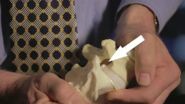(Press-News.org) Despite being outlawed in 2012 in the U.S., the synthetic drugs known as "bath salts" — which really aren't meant for your daily bath — are still readily available in some retail shops, on the Internet and on the streets. To help law enforcement, scientists are developing a novel method that could be the basis for the first portable, on-site testing device for identifying the drugs. They report their advance in the ACS journal Analytical Chemistry.
Craig E. Banks, in collaboration with Oliver Sutcliffe, notes that the high-inducing substances in bath salts, which are synthetic cathinones that also go by "plant food," "glass cleaner" and a number of other innocuous-sounding names, are derived from a stimulant in a plant called khat. The plant is found on the Arabian peninsula and East Africa. The drugs' effects are similar to those of amphetamines. Users reportedly feel an initial sense of euphoria, but this is followed by unpredictable and potentially dangerous effects, including seizures and hallucinations. Since bath salts first appeared in Europe and the U.S. more than four years ago, alarming reports emerged of users becoming violent. Tens of thousands of emergency room visits and several deaths have been attributed to the substances. Scientists have been working successfully on different techniques to identify the synthetic drugs, but the methods aren't portable. One group turned to an electrochemical approach, which can be adapted for in-the-field use, but their technique involved toxic mercury as the electrode. Banks' team wanted to find a better, safer way to perform bath salts "fingerprinting."
Using more environmentally friendly, mercury-free electrodes, the researchers developed a low-cost, disposable and rapid platform that could someday be used in a handheld sensor for detecting bath salts. They validated their technique using samples that were obtained from Internet vendors. The accuracy of their results matched that of established methods.
INFORMATION:
The American Chemical Society is a nonprofit organization chartered by the U.S. Congress. With more than 161,000 members, ACS is the world's largest scientific society and a global leader in providing access to chemistry-related research through its multiple databases, peer-reviewed journals and scientific conferences. Its main offices are in Washington, D.C., and Columbus, Ohio.
To automatically receive news releases from the American Chemical Society, contact newsroom@acs.org.
Follow us: Twitter Facebook
A novel method for portable detection of potent drugs known as 'bath salts'
2014-09-10
ELSE PRESS RELEASES FROM THIS DATE:
Scientists express concern over long-term vision for satellite-based research
2014-09-10
The U.S. has more than 30 civilian, Earth-observing satellites circling the planet, providing scientists with a torrent of crucial environmental and climate information. More satellites are on deck to launch in the next few years. But, according to an article in Chemical & Engineering News (C&EN), the weekly news magazine of the American Chemical Society, scientists have registered serious concerns over the lack of a long-term, cohesive vision for the scientific missions.
Jyllian Kemsley, a senior editor at C&EN, reports that satellites are marvels of technology. From ...
Penn engineers advance understanding of graphene's friction properties
2014-09-10
An interdisciplinary team of engineers from the University of Pennsylvania has made a discovery regarding the surface properties of graphene, the Nobel-prize winning material that consists of an atomically thin sheet of carbon atoms.
On the macroscale, adding fluorine atoms to carbon-based materials makes for water-repellant, non-stick surfaces, such as Teflon. However, on the nanoscale, adding fluorine to graphene had been reported to vastly increase the friction experienced when sliding against the material.
Through a combination of physical experiments and atomistic ...
Video game teaches kids how to code
2014-09-10
Computer scientists at the University of California, San Diego have successfully funded on Kickstarter a new and improved version of CodeSpells, a first-person player game they developed that teaches players how to code.
The game's previous iteration, developed by UC San Diego computer science Ph.D. students Sarah Esper and Stephen Foster, has been in use in dozens of schools throughout the world for more than a year. The researchers have been using the game as a platform to learn about the best ways to teach children how to code. They have presented their findings at ...
Thyroid cancer rates in Pennsylvania rising faster than rest of country
2014-09-10
Incidence of thyroid cancer is rising faster in Pennsylvania than in the rest of the United States, according to Penn State College of Medicine researchers.
"Since the mid-1970s, the incidence of thyroid cancer in the United States has more than tripled," said Dr. David Goldenberg, professor of surgery and medicine. "Thyroid cancer is now the seventh leading type of cancer in the nation. It typically occurs in young women and is projected to become the third most common cancer in women by 2019."
Papillary thyroid cancer, responsible for most of this increase, is very ...
An appetite for life
2014-09-10
A simple question about appetite can provide insights into old people's general health that may help reduce their risk of dying.
In a study published in the journal Appetite, Emeritus Professor Mark Wahlqvist from Monash University's Department of Epidemiology and Preventive Medicine and the Monash Asia Institute, led a team investigating the connection between appetite and mortality.
"Appetite is generally regarded as one of the most important indicators of health," Professor Wahlqvist said.
The urge to eat is often reduced in the elderly, with many afflicted by ...
Researchers unlock the genetic code of cancer-causing liver fluke parasite
2014-09-10
Singapore—An international team of scientists from Singapore, Thailand, China and Australia has cracked the genetic code of the liver fluke parasite, Opisthorchis viverrini, using a unique DNA analysis technique developed at A*STAR's Genome Institute of Singapore (GIS).
GIS's DNA analysis technique has allowed the researchers to further study the biology of Opisthorchis viverrini to understand the cause and the eventual development of treatments for bile duct cancer, a condition caused by the parasite. The breakthrough was published in the scientific journal Nature Communications.
Opisthorchis ...
Back pain killing your sex life?
2014-09-10
VIDEO:
Contrary to popular belief, spooning is not always the best sex position for those with a bad back, according to research from the University of Waterloo. For the first time...
Click here for more information.
Contrary to popular belief, spooning is not always the best sex position for those with a bad back, according to new research from the University of Waterloo.
For the first time ever, scientists have successfully documented the way the spine moves during sex ...
US cityscapes show consistent patterns of 'urban evolution'
2014-09-10
Most people think of city landscapes as simpler, diminished versions of the wild forests and free-flowing streams found in remote places. But in a series of studies published Sept. 10, 2014 in a special issue of the journal Biogeochemistry, scientists specializing in urban ecosystems say just the opposite is true. Urban landscapes are more complex than they seem, and from coast to coast these ecosystems can work in surprisingly similar ways, regardless of local conditions. And they have the potential to change quickly – for better or worse – depending on how people manage ...
Study shows that in baboons, as well as humans, social relationships matter
2014-09-10
Elizabeth Archie, Clare Booth Luce Assistant Professor in the Department of Biological Sciences at Notre Dame and colleagues used an incredibly rich data set on the social relationships of wild baboons which was collected on an almost daily basis, year-round, since 1984 by the Amboseli Baboon Research Project. The project, which Archie helps direct, is a long-term study of wild baboons that follows the lives of individual baboons, watching what they do and who they interact with.
"We can tell individual baboons apart by distinct features of their appearance, such as their ...
Teens' neural response to food commercials predicts future weight gain
2014-09-10
Children and adolescents see thousands of food commercials each year and most of them advertise junk foods high in sugar, fat and salt. Yet, we know almost nothing about how all of this food marketing impacts the brain, especially for teens. New research suggests that food commercials "get under the skin" of teens by activating reward regions when they are viewing ads for milk shakes, or burgers, or colas. The bad news for us is that this can result in weight gain and obesity.
In the first prospective longitudinal study to investigate neural response to unhealthy food ...





